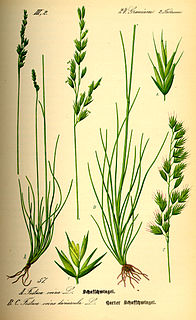Related Research Articles
NVC community CG7 is one of the calcicolous grassland communities in the British National Vegetation Classification system. It is one of three short-sward communities associated with heavy grazing, within the lowland calcicolous grassland group, and is regarded as the eastern counterpart of "typical" chalk grassland.

Festuca ovina, sheep's fescue or sheep fescue, is a species of grass. It is sometimes confused with hard fescue.
This article gives an overview of the plant communities formed by vegetation of open habitats in the British National Vegetation Classification system.
NVC community SD11 is one of the 16 sand-dune communities in the British National Vegetation Classification system.
NVC community U6 is one of the calcifugous grassland communities in the British National Vegetation Classification system.
NVC community H5 is one of the heath communities in the British National Vegetation Classification system. It is one of three communities which are considered transitional between the lowland dry heaths and the wetter communities classified in the NVC as mires.
NVC community SD12 is one of the 16 sand-dune communities in the British National Vegetation Classification system.
NVC community H6 is one of the heath communities in the British National Vegetation Classification system. It is one of five communities categorised as lowland dry heaths.
NVC community H7 is one of the heath communities in the British National Vegetation Classification system. It is one of two communities categorised as maritime heaths.
British NVC community MC10 is one of the maritime cliff communities in the British National Vegetation Classification system. It is one of five communities categorised as maritime sea-cliff grasslands.
NVC community CG10 is one of the calcicolous grassland communities in the British National Vegetation Classification system. Of the upland group of calcicolous grasslands, it is the only one with a short sward associated with heavy grazing.
British NVC community OV41 is one of the open habitat communities in the British National Vegetation Classification system. It is one of six communities of crevice, scree and spoil vegetation.
British NVC community OV39 is one of the open habitat communities in the British National Vegetation Classification system. It is one of six communities of crevice, scree and spoil vegetation.
British NVC community MC5 is one of the maritime cliff communities in the British National Vegetation Classification system. It is one of five communities categorised as maritime cliff crevice and ledge communities.
British NVC community MC12 is one of the maritime cliff communities in the British National Vegetation Classification system. It is one of five communities categorised as maritime sea-cliff grasslands.
NVC community CG1 is one of the calcicolous grassland communities in the British National Vegetation Classification system. It is one of three short-sward communities associated with heavy grazing, within the lowland calcicolous grassland group, and is regarded as the south-west coastal counterpart of "typical" chalk grassland.
British NVC community OV18 is one of the open habitat communities in the British National Vegetation Classification system. It is one of six communities characteristic of gateways, tracksides and courtyards.
British NVC community OV24 is one of the open habitat communities in the British National Vegetation Classification system. It is one of four tall-herb weed communities.
British NVC community OV27 is one of the open habitat communities in the British National Vegetation Classification system. It is one of four tall-herb weed communities.
British NVC community OV38 is one of the open habitat communities in the British National Vegetation Classification system. It is one of six communities of crevice, scree and spoil vegetation.
References
Rodwell, John S, ed. (March 2000). Maritime communities and vegetation of open habitats. British Plant Communities. Vol. 5. Cambridge University Press. ISBN 978-0-521-39167-2.
Shimwell, D W (1968). The phytosociology of calcareous grasslands in the British Isles (PhD thesis). Durham University.